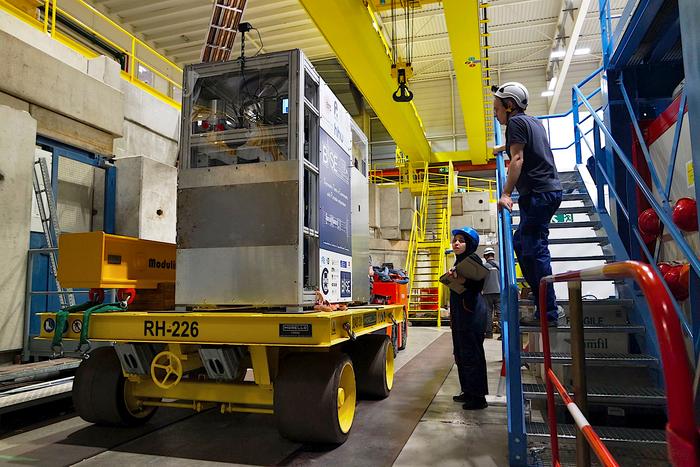Stars, planets, humans, and corgis are all made of matter, but in the universe exists its opposite, which is known as antimatter. Matter and antimatter have opposite electric charges, but their other properties are the same. Or are they? There must be a reason why the universe is almost exclusively matter; the answer might be in a small difference in specific properties. Tests have been underway, but sometimes you can’t take your measurement where the antimatter is being produced in “bulk” – so researchers had to come up with a strategy to move it.
In an incredible breakthrough, researchers from the BASE collaboration, working at the Institute for Experimental Physics in Düsseldorf and at CERN, have shown that it is possible to keep particles suspended for at least four hours on independent power being driven around in a van. The experiment was done with protons, the particles at the center of all atoms, as a test for a real antimatter transport later this year.
“This is really new technology. It’s something which is pioneering, and it has a very strong multiplicative impact. Because if we manage to do this now within our own universe, the BASE collaboration, of course, we can multiply these experiments and we can transport antiprotons to many different laboratories,” Professor Stefan Ulmer, BASE collaboration spokesperson, told IFLScience.
Antimatter annihilates when it comes into contact with regular matter. That means that it turns into pure energy – not just the sides of the container, but also the molecules in the air. So, transporting it safely is not easy. They used a transportable, superconducting, autonomous, battery-powered, and “open” Penning trap system built by Dr Christian Smorra. It’s called BASE-STEP.
A Penning trap is a device that can confine electrically charged particles thanks to electric and magnetic fields. The fact that it is open means that it can be easily plugged into experiments elsewhere to safely deliver the antimatter.
The gasoline in the truck tank is a million times more dangerous than the antimatter.
Professor Stefan Ulmer
The specific motivation to do this is to improve measurements by making them 100 times more precise, and at the moment, one big obstacle to reaching that precision is the very accelerator that produces the antimatter particles at CERN’s Antimatter Factory. The detector is incredibly sensitive in that it picks up the accelerator’s magnets several meters and blocks of concrete below.
“I recently did a rough calculation of how long we would need to make better measurements while the accelerator is on in the accelerator hall. And I ended up at an estimate of something like seven years per measurement,” Professor Ulmer told IFLScience.
Instead of waiting decades for better measurements, the team decided that they could collect antimatter and move it to an experiment (currently in development) just as sensitive, but without the accelerator making the measurements more difficult. The challenge was in traveling with antimatter. Thanks to Smorra’s Penning trap, now it seems to be possible.
BASE-STEP being transported across the Antimatter Factory while being monitored by BASE’s Fatma Abbass and Dr Christian Smorra.
Image Credit: BASE Collaboration/Maria Latacz
“We are trying to do it this year. We have the trap now in Düsseldorf for some maintenance and upgrades. It’s standing in the lab next door to my office. We hope to transport the revised trapping system by the end of July,” Professor Ulmer told IFLScience. “And then we have in principle time to kind of catch antiprotons and demonstrate the transport until the end of the year. So in the window, let’s say between the end of August and beginning of December, we’ll try to make this happen.”
Naturally, people hear “antimatter” and think of some devastating material that can wipe out a city. Sure, if you had a half a gram of antimatter, you could devastate a city, but with current technology, you’d need 500 million years to produce half a gram of antimatter. The transport will move at most 100 antiprotons.
“The most dangerous thing in this entire transport is that the truck will have an accident because the gasoline in the truck tank is a million times more dangerous than the antimatter,” Professor Ulmer told IFLScience.
The ability to move antimatter is opening a new window in the way we study reality. We might finally know why the universe is made of matter and not antimatter.
The study, led by Marcel Leonhardt, is published in the journal Nature.
Source Link: How Do You Move Antimatter If It Violently Reacts With Regular Matter?
